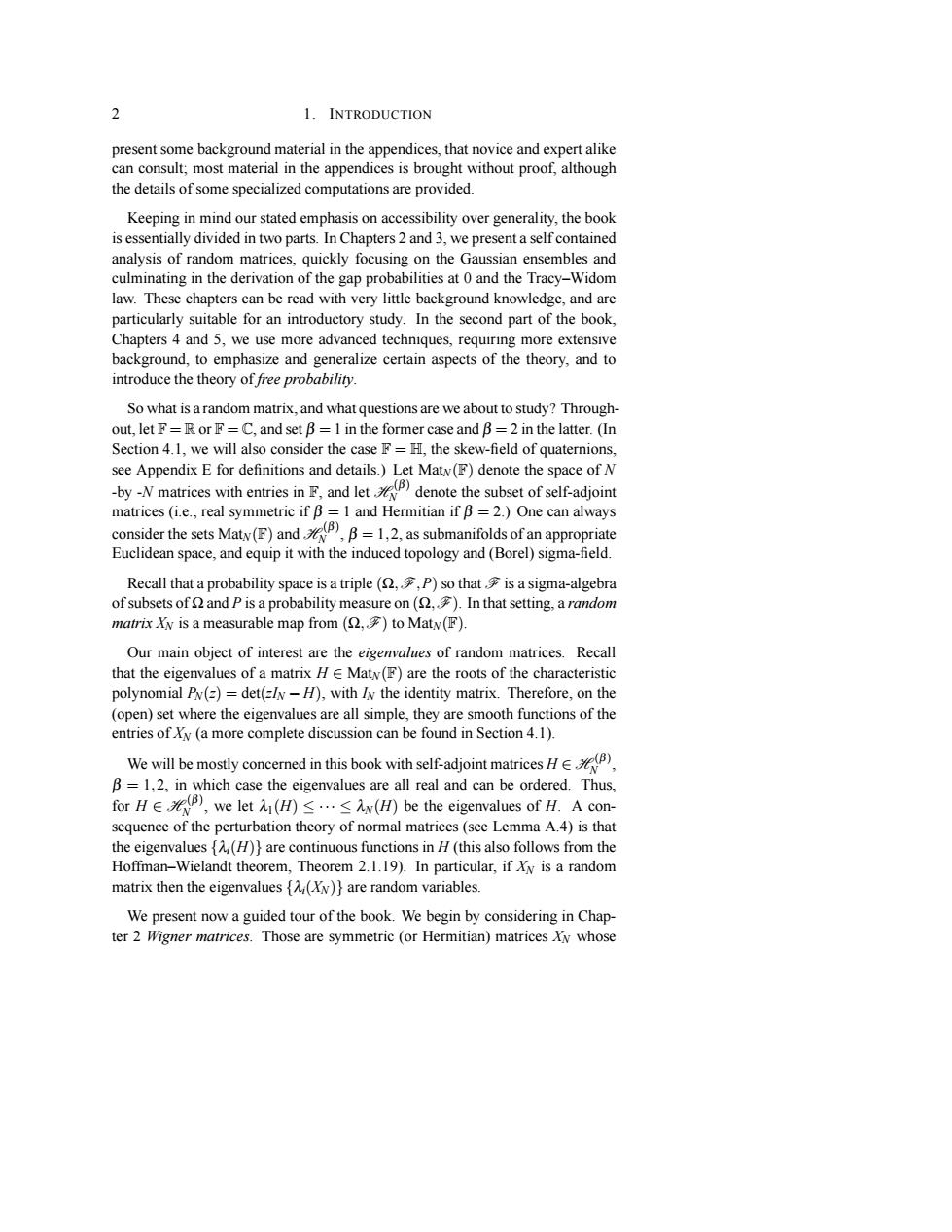正在加载图片...

1.INTRODUCTION present some background material in the appendices,that novice and expert alike can consult;most material in the appendices is brought without proof,although the details of some specialized computations are provided. Keeping in mind our stated emphasis on accessibility over generality,the book is essentially divided in two parts.In Chapters 2 and 3,we present a self contained analysis of random matrices,quickly focusing on the Gaussian ensembles and culminating in the derivation of the gap probabilities at 0 and the Tracy-Widom law.These chapters can be read with very little background knowledge,and are particularly suitable for an introductory study.In the second part of the book, Chapters 4 and 5,we use more advanced techniques,requiring more extensive background,to emphasize and generalize certain aspects of the theory,and to introduce the theory of free probability. So what is a random matrix,and what questions are we about to study?Through- out,let F=R or F=C,and set B=1 in the former case and B=2 in the latter.(In Section 4.1,we will also consider the case F=H,the skew-field of quaternions, see Appendix E for definitions and details.)Let Matw(F)denote the space of N -by-N matrices with entries in,and let denote the subset of self-adjoint matrices (i.e.,real symmetric if B=I and Hermitian if B=2.)One can always consider the sets Maty(F)andB-1,2,as submanifolds of an appropriate Euclidean space,and equip it with the induced topology and(Borel)sigma-field. Recall that a probability space is a triple (,P)so that is a sigma-algebra of subsets of and P is a probability measure on(,).In that setting,a random matrix Xy is a measurable map from (,to Matw(F). Our main object of interest are the eigemalues of random matrices.Recall that the eigenvalues of a matrix HE Maty(F)are the roots of the characteristic polynomial P(=)=det(=IN-H),with IN the identity matrix.Therefore,on the (open)set where the eigenvalues are all simple,they are smooth functions of the entries of Yy (a more complete discussion can be found in Section 4.1) We will be mostly concered in this book with self-adjoint matrices HB) B=1,2,in which case the eigenvalues are all real and can be ordered.Thus, for HE光),we let(l≤…≤2w(l)be the eigenvalues of H.Acon- sequence of the perturbation theory of normal matrices (see Lemma A.4)is that the eigenvalues {(H)}are continuous functions in H(this also follows from the Hoffman-Wielandt theorem,Theorem 2.1.19).In particular,if Xy is a random matrix then the eigenvalues (X)}are random variables. We present now a guided tour of the book.We begin by considering in Chap- ter 2 Wigner matrices.Those are symmetric (or Hermitian)matrices Xy whose2 1. INTRODUCTION present some background material in the appendices, that novice and expert alike can consult; most material in the appendices is brought without proof, although the details of some specialized computations are provided. Keeping in mind our stated emphasis on accessibility over generality, the book is essentially divided in two parts. In Chapters 2 and 3, we present a self contained analysis of random matrices, quickly focusing on the Gaussian ensembles and culminating in the derivation of the gap probabilities at 0 and the Tracy–Widom law. These chapters can be read with very little background knowledge, and are particularly suitable for an introductory study. In the second part of the book, Chapters 4 and 5, we use more advanced techniques, requiring more extensive background, to emphasize and generalize certain aspects of the theory, and to introduce the theory of free probability. So what is a random matrix, and what questions are we about to study? Throughout, let F = R or F = C, and set β = 1 in the former case and β = 2 in the latter. (In Section 4.1, we will also consider the case F = H, the skew-field of quaternions, see Appendix E for definitions and details.) Let MatN(F) denote the space of N -by -N matrices with entries in F, and let H (β) N denote the subset of self-adjoint matrices (i.e., real symmetric if β = 1 and Hermitian if β = 2.) One can always consider the sets MatN(F) and H (β) N , β = 1,2, as submanifolds of an appropriate Euclidean space, and equip it with the induced topology and (Borel) sigma-field. Recall that a probability space is a triple (Ω,F,P) so that F is a sigma-algebra of subsets of Ω and P is a probability measure on (Ω,F). In that setting, a random matrix XN is a measurable map from (Ω,F) to MatN(F). Our main object of interest are the eigenvalues of random matrices. Recall that the eigenvalues of a matrix H ∈ MatN(F) are the roots of the characteristic polynomial PN(z) = det(zIN − H), with IN the identity matrix. Therefore, on the (open) set where the eigenvalues are all simple, they are smooth functions of the entries of XN (a more complete discussion can be found in Section 4.1). We will be mostly concerned in this book with self-adjoint matrices H ∈ H (β) N , β = 1,2, in which case the eigenvalues are all real and can be ordered. Thus, for H ∈ H (β) N , we let λ1(H) ≤ ··· ≤ λN(H) be the eigenvalues of H. A consequence of the perturbation theory of normal matrices (see Lemma A.4) is that the eigenvalues {λi(H)} are continuous functions in H (this also follows from the Hoffman–Wielandt theorem, Theorem 2.1.19). In particular, if XN is a random matrix then the eigenvalues {λi(XN)} are random variables. We present now a guided tour of the book. We begin by considering in Chapter 2 Wigner matrices. Those are symmetric (or Hermitian) matrices XN whose